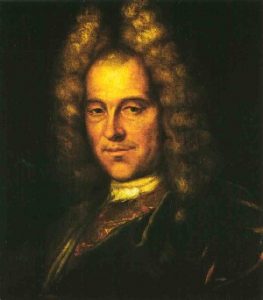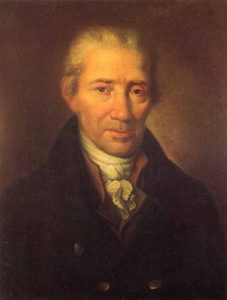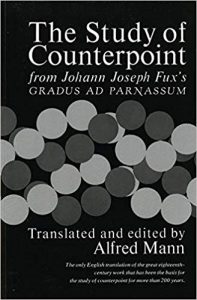
We mark the presumed birth on February 3, 1525 – 495 years ago today – of the Rome-based Italian composer Giovanni Pierluigi da Palestrina. Unlike virtually every other great composer of the Renaissance, a list of which includes such formidable names as Josquin des Prez, William Byrd, Giovanni Gabrieli, Guillaume Dufay, Orlande de Lassus, and Johannes Ockeghem, Palestrina’s name, reputation, and music have never faded from view since his death in 1593. The staying power of his name, reputation, and music can be attributed to three of factors, all of which will be explored in today’s Music History Monday post and tomorrow’s Dr. Bob Prescribes post (which can be accessed at Patreon.com/RobertGreenbergMusic). These factors are, one, Palestrina’s posthumous reputation as the ostensible “savior” of Catholic church music during the conservative, austere artistic climate of the Counter Reformation (which will be discussed in tomorrow’s Dr. Bob Prescribes); two, his personal compositional style, which was (and still is) embraced as a paradigm of utopian perfection and has thus been employed in teaching counterpoint since the early seventeenth century; and three (and most importantly), the fact that he wrote a tremendous amount of first rate music, the great bulk of which is sacred.
His collected works include 104 Masses (an extraordinary number and by strange coincidence the same number of symphonies attributed to Joseph Haydn); well over 300 motets (which are vocal liturgical works of varying length); over 140 madrigals (secular vocal works of varying length); 68 offertories (that is, music that accompanies the procession of the faithful bearing the bread and wine – the symbolic body and blood of Christ – as well as other gifts/offerings for the Church); 35 magnificats (which means “magnifies”, as in “My soul magnifies the Lord”), a setting of the “Song (or canticle) of Mary”, the text of which comes from the Gospel of Luke; 72 hymns; 11 litanies; numerous sets of lamentations; etc.; all told, a lot of music.
Giovanni Pierluigi was born in Palestrina, an ancient city in the Sabine Hills 22 miles (or so) east-southeast of Rome. While his earliest education took place there in Palestrina, Giovanni Pierluigi (or “Gianetto” as he was nicknamed) spent the great bulk of his student days, apprenticeship, and career within the confines of the three most important churches in the holy city of Rome: Santa Maria Maggiore, Saint John Lateran, and Saint Peter’s.

In 1554, the 29-year-old Palestrina dedicated his first published book of masses to Pope Julius III, who had previously been known to Palestrina as the Bishop of Palestrina. (The truism holds: it’s not just what you know, but who you know.) The dedication to Pope Julius was clearly the politic thing to do, because just a few months later, on January 13, 1555, Palestrina was appointed as a chorister in the single most prestigious choir in Christendom: that of the Sistine Chapel, the pope’s “personal” chapel. Palestrina’s hiring was controversial: he was neither a priest nor even celibate, but rather married (*gasp!*). According to the “Diarii Sistina” – the diaries of the Sistine Chapel – Palestrina was hired:
“on the orders of His Holiness Pope Julius, without any examination and without the consent of the singers.”
We can safely assume that Palestrina’s extraordinary talents quickly overcame any residual resistance from his fellow choristers. Unfortunately, Pope Julius III died just three months after Palestrina’s appointment to the Sistine choir, and he was succeeded by Cardinal Marcello Cervini, who took the papal (as distinct from “PayPal”) name of Marcellus II. Sadly, the shelf life for popes was on the short side at the time, and Marcellus’ papacy lasted for all of three weeks. However, it’s very likely that the title of Palestrina’s Pope Marcellus Mass – the topic of tomorrow’s Dr. Bob Prescribes post – reflects an event that took place on the third day of the Marcellus’ all-too-short reign, when, on Good Friday of 1555, he informed his singers:
“that the music for Holy Week should be more in keeping with the character of the occasion and that as far as possible the words should be clearly understood.”

Marcellus was succeeded by the ancient, 79-year-old (this was when 79 years was 79 years!), existentially crotchety Cardinal Gian Pietro Carafa, who ruled under the name of Paul IV. In his four years as pope, Paul IV managed to earn a reputation as one of the cruelest and most hated popes in history. (Immediately after his death, his statue on the Campidoglio was decapitated by a mob and then thrown into the Tiber River, certainly not a sign of high popularity.) Anyway, among the first things Paul IV did on attaining the papacy was to enforce the Sistine Chapel’s long-ignored rule on celibacy, with the result that along with two other married singers, Palestrina was summarily fired in September 1555, just nine months after having been appointed to the Sistine choir.
From there Palestrina went on to become maestro di cappella (director of music)at the Archbasilica Saint John Lateran and later, at the Papal Basilica of Santa Maria Maggiore. Through it all Palestrina composed, not just for the churches of Rome but for churches across Italy. His reputation as a composer continued to grow, and by the 1570s we are told that he was held in awe by his contemporaries. In 1575, an official working for the Duke of Ferrara wrote that Palestrina was:
“now considered the very first musician in the world.”
By the early seventeenth century Palestrina’s music was being praised by not just listeners and other composers, but by music theorists as well. These theorists perceived Palestrina’s subtle, refined, carefully controlled, intensely lyric compositional style – in which the words remained clear no matter how dense the polyphony – as being an ideal sort of music, a sort of music that should be a model for other composers.“Palestrinan counterpoint” became a discipline and a course of study unto itself.

Palestrina’s compositional style was codified by an Austrian composer, theorist and pedagogue named Johann Joseph Fux (ca. 1660-1741), whose book Gradus ad Parnassum (meaning “Steps to Paradise”) was published in 1725. Fux broke Palestrina’s contrapuntal technique down into five types or “species” of counterpoint. In the nearly 300 years since, Palistrinan “species counterpoint” as codified and described by Fux has been the bedrock of counterpoint pedagogy, making Fux’s Gradus among the most important and widest read books on music ever written.
Johann Sebastian Bach, who was 40 years old when Gradus was published, held the book in the highest esteem.
According to Joseph Haydn’s first biographer, his personal friend Georg August von Griesinger (1769 – 1845):
“Haydn took infinite pains to assimilate the theory of Fux; he went through the whole work laboriously, writing out the exercises, then laying them aside for a few weeks, to look them over again later and polish them until he was satisfied he had done everything exactly right.”
Leopold Mozart instructed his son Wolfgang from his personal copy of Fux’s Gradus ad Parnassum; that copy – inscribed “1746 Ex Libris Leopoldi Mozart” – rests today in Salzburg. Perhaps even more importantly, Mozart himself used the Gradus later in life when he himself taught.

When Beethoven moved to Vienna to study composition with Haydn in 1792, that instruction came from Fux’s Gradus. When Beethoven “demanded a more systematic instruction than Haydn was, by age and temperament, disposed to give”, he turned to a pedant named Johann Georg Albrechtsberger (1736-1809), who also instructed Beethoven from Fux’s Gradus. Beethoven went on to use the Gradus in the instruction of his composition student Archduke Rudolph Johann Joseph Rainier (to whom Beethoven dedicated fourteen compositions, including his Piano Concerto No. 5, the “Emperor” (Opus 73; 1809); the Archduke Piano Trio (Opus 97; 1811); the Hammerklavier Piano Sonata (Opus 106; 1818); and the Missa Solemnis (Opus 123; 1823).
When Fux’s Gradus ad Parnassum was translated into French in 1833 and sold by subscription, the subscribers included Hector Berlioz, Luigi Cherubini, Giacomo Meyerbeer, Frédéric Chopin, Gioachino Rossini, Niccolò Paganini, Ignaz Moscheles, Johann Nepomuk Hummel, and Franz Liszt. Franz Schubert, Johannes Brahms, and Anton Bruckner all studied Palestrinan counterpoint using the original, Latin-language version of Fux’s Gradus ad Parnassum.

And so it has continued. My Freshman year music theory and counterpoint textbook was The Study of Counterpoint, which is Alfred Mann’s English-language translation of Fux’s Gradus ad Parnassum. The course in species counterpoint that was my Freshman year music theory curriculum provided the basis for my own compositional technique, as well as the techniques of my fellow students.
It is in this way that the substance and spirit of Palestrina’s music and compositional style survives today as a living, breathing, utterly contemporary thing. As such, he must be considered among the most influential composers of all time. Here’s how Felix Mendelssohn put it:
“I always get upset when some praise only Beethoven, others only Palestrina and still others only Mozart or Bach. All four of them, I say, or none at all.”
For more on the music of Palestrina, I would humbly direct your attention to my 48-lecture course, How to Listen to and Understand Great Music (Published by The Great Courses).
Listen on the Music History Monday Podcast
Podcast: Play in new window
Subscribe: Apple Podcasts | Spotify | Pandora | iHeartRadio | RSS | More
